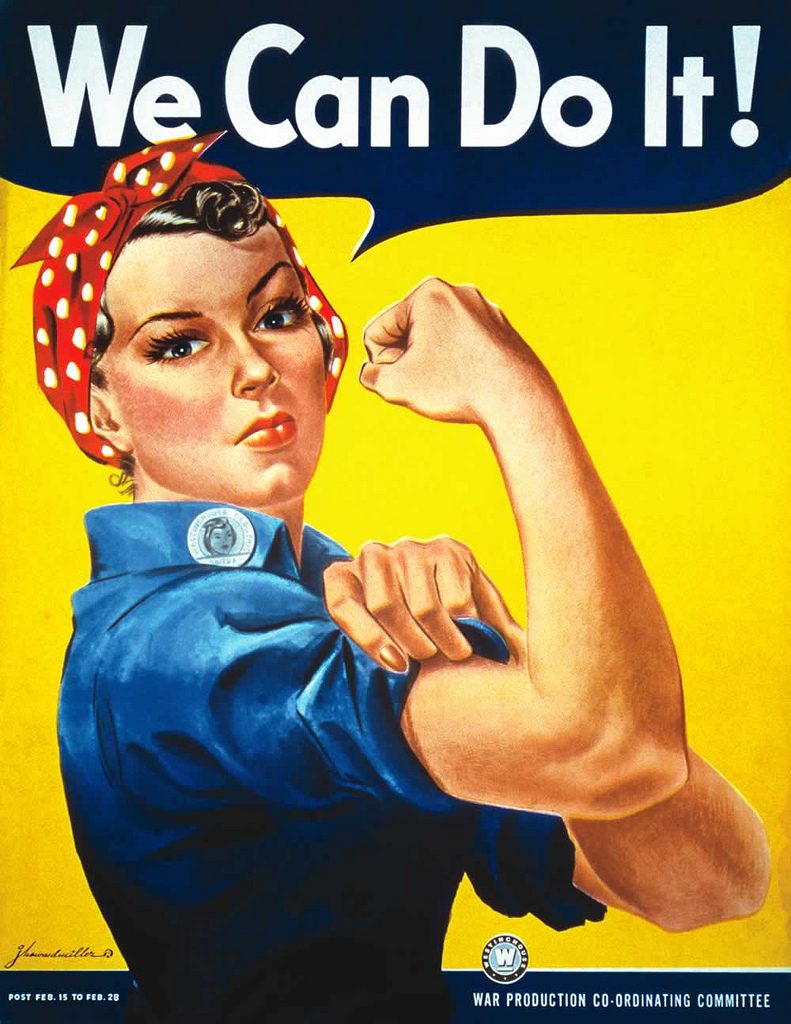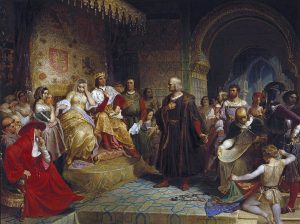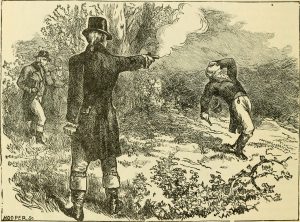From 1941 to 1945, during World War II, many woman were needed in the workplace because millions of men had joined the armed forces to fight in the European and the Pacific theaters of the war. In the Depression years just before this, women had been encouraged to stay at home, and let the men take the reduced number of manufacturing jobs available.1 With the onset of the war and the dramatically increased demand for manufactured wartime products, factories across the country opened their doors to women workers by the millions. In fact, there was a concerted effort to enlist women into the work force. In 1942, artist J. Howard Miller created the popular image of a woman named “Rosie the Riveter.” This poster was initially named, “We Can Do It!” and was made for the Westinghouse Electric and Manufacturing Company. Rosie was represented wearing makeup, a polka dot headband, and a rolled up sleeve shirt that portrayed strength and independence in women.2

Rosie the Riveter was a fictional character that many woman in the workforce identified with. The initial purpose of her image was to influence women to see themselves as capable of doing work previously thought to be men’s work. Her image combined beauty and strength, which is why many woman saw her as a role model. Even though Rosie the Riveter was a fictional character, her image was actually based on a photograph of a woman named Geraldine Doyle, who was a Michigan factory worker.3
There were some jobs that women took on that required training. Because of this, their wages were higher due to the fact that their jobs were more challenging and engaging compared to jobs that they may have had before. During the war, eighteen million women referred to themselves as being “Rosies.” Out of these eighteen million Rosies, six million had the opportunity to work for the first time. These women understood that the U.S. military and economy needed them; however, what motivated them to work was their own patriotism.4
In 1942, before Miller’s poster was created, Redd Evans and John Jacob Loeb wrote a song called, “Rosie the Riveter.” This hit song had lyrics that acknowledged and recognized the work that women did during the war:
All the day long whether rain or shine
She’s a part of the assembly line
She’s making history,
working for victory
Rosie the Riveter.
Keeps a sharp lookout for sabotage
Sitting up there on the fuselage
That little frail can do
more than a male will do
Rosie the Riveter.5
The song became associated with the existing images of Rosie the Riveter, which was a perfect blend of patriotism and beauty and strength in women.6
Unfortunately, after the war, the jobs and wages that Rosies had adapted to their lifestyles came to an end for the majority of them. Some went back to working “less challenging” jobs, and some became stay-at-home mothers. Because of this, birth rates increased, which led to the baby boom that lasted from 1946 through 1964. Even though many women went back to their previous lifestyles, they claimed to have left the workforce more confident and had more self-worth, knowing that they had proved to society that they were capable of doing men’s work.7
World War II changed the lifestyles of women significantly. Going from housewives to working in different industries allowed women to prove to society that this type of work was not just for men. There may have been no intention for women to prove themselves what they are capable of; however, women did leave their jobs after the war feeling better about themselves. Rosie the Riveter remains an iconic figure in American history, representing not only beauty in women, but also strength, courage, and confidence.
- Encyclopedia of Sex and Gender, 2007, s.v. “Rosie the Riveter,” by Susan L. Solomon. ↵
- America in the World, 1776 to the Present: A Supplement to the Dictionary of American History, 2016, s.v. “Rosie the Riveter,” by Nichola D. Gutgold. ↵
- Encyclopedia of Sex and Gender, 2007, s.v. “Rosie the Riveter,” by Susan L. Solomon. ↵
- Encyclopedia of Sex and Gender, 2007, s.v. “Rosie the Riveter,” by Susan L. Solomon. ↵
- Redd Evans and John Jacob Loeb, “Rosie the Riveter,” (New York: Paramount Music Corporation, 1942); The Four Vagabonds, “Rosie the Riveter,” recorded RCA Manufacturing Co., 1943. ↵
- America in the World, 1776 to the Present: A Supplement to the Dictionary of American History, 2016, s.v. “Rosie the Riveter,” by Nichola D. Gutgold. ↵
- Encyclopedia of Sex and Gender, 2007, s.v. “Rosie the Riveter,” by Susan L. Solomon. ↵



89 comments
Jasmine Rocha
I had always seen this poster in the walls in many classrooms growing up but now knowing the historical context of it I can see how it was more impactful and had a bigger meaning to women especially those who had to enter the workforce. This fictional character based on one woman was the image for women in the workforce after many men left for the war just as an inspiration to keep working harder and part of women patriotism. It makes me sad how many women had to take on a different role after the men came back after the war either less challenging jobs or as stay home wives or moms.
Daniela Duran
I had seen the picture of Rosie many times in my life, and I had never even thought of what it meant! I now feel impressed by the fact that it has such an inspirational background. I am definitely a feminist…I believe that women can do everything that men can, and so I truly enjoyed reading this article about how women empowered themselves to do things that were note expected of them. I like the fact that Rosie was designed to be both beautiful and strong, because it captures the fact that women are completely capable of doing anything, without losing the femininity that characterizes us. I really enjoyed this article, and now, when I see this poster, I will definitely feel more identified with its meaning!
Diego Aguilera
Even though this woman wasn’t real, the symbol she displayed was so empowering and really made a statement to give women that extra push and really tell them, “hey you got this” because of the many men in World War II. The Great Depression was a really downfall that lead to many success for our country. I did learn a lot as I didn’t know Rosie wasn’t real but a symbol. The video that was attached was very cool and helped me grasp the concept more.
Honoka Sasahara
I like such campaign that makes us recognize the strength or power of women because we tend to believe the limit that someone determines just by gender. Simultaneously, however, I found expectation of manufacturing company to make women being more willing to work as improve working female’s image. I guess it was good way for women ultimately could know that housekeeping was not the only job for them, and that they had more possibility.
Mariah Garcia
I remember in school, very faintly, learning about Rosie the Riveter. I knew about the significance of the poster during WWII but I’m, still astonished on how it still affects women today. I think it is wonderful the revolution she created. The poster was a movement towards gender equality and tells a story ’til this day. I did hear another story of how the inspiration for the Rosie the Riveter became. It was Naomi Parker Fraley a woman who worked in the factory during WWII. That would be another great article to read. But overall this article was interesting!
Luisa Ortiz
Even though Rosie the Riveter was not real, just an image it did empower women during the WWII and until today’s day, this image still empowering and known for strong, independent, beautiful women. I see it as “the best” marketing/design of its time. it serves the purpose it gives thousands of women a face where they can see their identity. I will really like to see Rosie Riveter portraying not just for Anglo women but for ALL women of every color and race represented.
Lorenzo Rivera
Rosie the riveter although fictional, opened the door to the working women of America in the era. I have always heard about her in school, and her picture is very iconic in our country, and all over the world. She helped break the stigma behind male and female specific jobs, and careers. She is an inspiration to men and women everywhere, and will continue to spread the image of working women in America for generations to come.
Crystal Baeza
I’ve always heard of Rosie the Riveter and knew about her famous image but never knew she was a fictional character! Even though she wasn’t real, her one of a kind portrait motivated women across the country. She gave women hope in working in a field only know for men. I love how even years before today women were pushing forward for equality for both sexes. If it wasn’t for the Rosie maybe women wouldn’t have been eager to get in the work force and show their full potential in working outside of home. It’s crazy what a simple piece of artwork can mean to others and motivate them to step outside their boundaries.
Jonathan Arreola
I have always been familiar with the iconic depiction of Rosie the Riveter, however, never have I been aware of the important meaning behind the popular image. I was shocked to find out that Rosie is actually a fictional character, an idea, an imaginary muse that all woman looked upon. Rosie created a revolution, the leaping movement towards gender equality. I enjoyed the addition of the short video, the song was catchy and clearly highlighted the new concept of women in the workforce. Im glad I have finally learned the meaning behind the depiction of Rosie the Riveter, the influential figure that continues to be idolized until modern day.
Alexandra Cantu
I loved this article plus I learned something new. I previously had heard of Rosie the Riveter but never of her story. I always see many women dress up as herring Halloween and think this lady but be a badass cause so many women love to dress up as her. She made supported equality for men and women for equal pay. Rosie truly inspired the feminine revolution. She is truly a badass. This was great work.